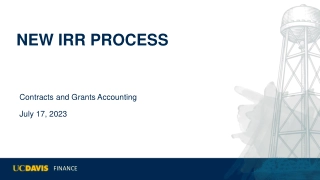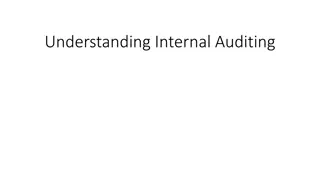Understanding Internal Rate of Return (IRR) in Investments
Internal Rate of Return (IRR) is a method used to assess the profitability of potential investments by calculating the discount rate that makes the net present value of an investment zero. It considers the time value of money and helps in comparing projects based on their returns relative to costs. IRR has advantages like incorporating time value of money and not needing a hurdle rate, but it also has limitations such as not accounting for changing expenses and being sensitive to project duration. Despite its drawbacks, IRR is valuable for businesses evaluating investments and individuals making financial decisions. It is used in various scenarios like stock buybacks, insurance policy comparisons, and calculating money-weighted rates of return.
Download Presentation

Please find below an Image/Link to download the presentation.
The content on the website is provided AS IS for your information and personal use only. It may not be sold, licensed, or shared on other websites without obtaining consent from the author. Download presentation by click this link. If you encounter any issues during the download, it is possible that the publisher has removed the file from their server.
E N D
Presentation Transcript
WHAT IS THE INTERNAL RATE OF RETURN? The Internal rate of return is a method used to estimate the profitability of the potential investment. It is the discount rate that makes the net present value of an investment equals zero. The Internal rate of return method is widely used in discounting cash flow analysis, and also used budgeting method. While calculating the IRR, the present value of future cash flows equals the initial investment of the project, and thus makes the NPV = 0.After calculating the IRR, it should be compared with the minimum required rate of return or cost of capital of the project. For example, If the calculated IRR is found greater than the minimum required rate of return, then the project should be accepted whereas If the calculated IRR is found lesser than the minimum required rate of return, then the project should be rejected. for analyzing capital
ADVANTAGES OF IRR The finest feature of internal rate of return is that it takes time value of money into account. The value of money received today is greater than the value of money to be received tomorrow. This is so because the funds obtained now can be invested and used to produce cash flows that will support new businesses Additionally, unlike capital budgeting, IRR does not require a hurdle rate. This is because businesses evaluate the IRRs of several projects to determine the best Simply determining whether a project's internal rate of return exceeds its costs can determine whether or not it is worthwhile. in the future. investment strategy.
DISADVANTAGES OF IRR The objective of IRR is to ascertain the anticipated cash flow from the capital injected. It doesn't take into account possible expenses like fuel and maintenance prices, which change over time. As a result, future profits suffer. Another disadvantage is that it assumes that future cash flows can be invested at the same internal rate of return. Third disadvantage is that the figures obtained by IRR can be pretty high. Moreover, calculations consuming and tedious. Making investment decisions based only on internal rate of return can be risky, especially when comparing two projects with different durations. Consider this example of IRR. This is a scenario in which a company's hurdle rate is 12 per cent. Project A has a one-year IRR of 25 per cent. But, Project B has a five-year IRR of 15 per cent. If IRR is the only factor taken into consideration, Project A will be foolishly chosen above project B. are both time-
WHAT IS THE INTERNAL RATE OF RETURN USED FOR? Internal rate of return is helpful for businesses when assessing stock buyback demonstrate that the company's investment that is, has a higher IRR than any other use of the cash. IRR can be used by individuals while making financial decisions, such as comparing various insurance policies based on their premiums and death benefits. Policies with the same premiums and a high IRR are far more rewarding. Life insurance has an IRR that is frequently above 1,000 per cent in the first few years of the policy. It then gradually gets smaller. The money-weighted rate of calculated using the IRR formula (MWRR). By taking into account all variations in cash flows throughout the investment period, including sales proceeds, the MWRR aids in calculating the rate of return required to start with the initial investment amount. plans. The stock research is must better a return on investment is























